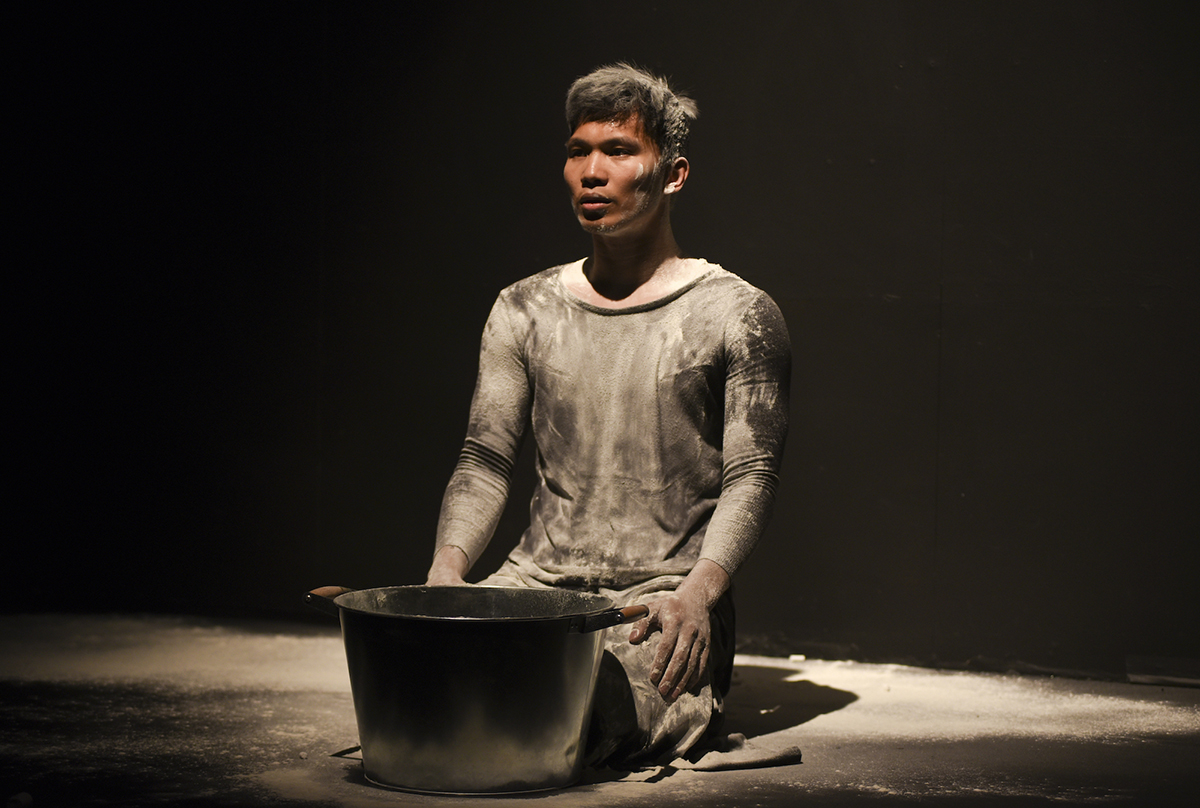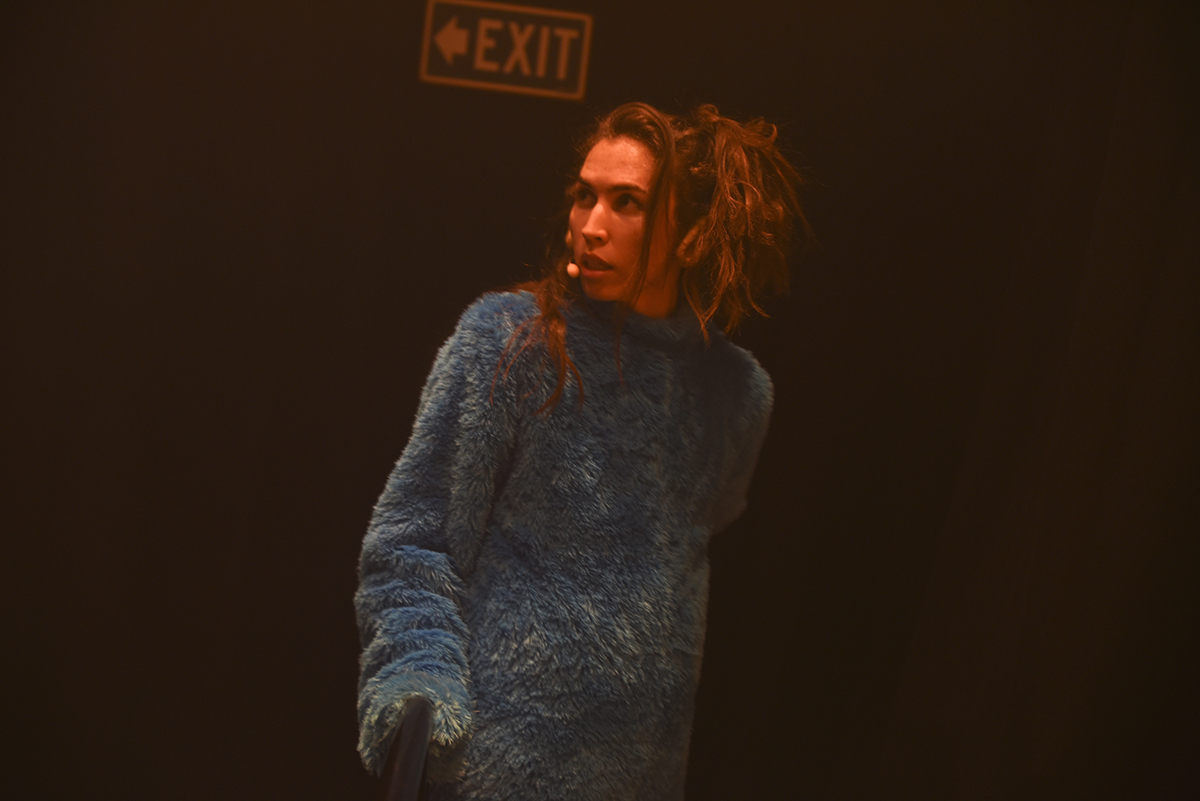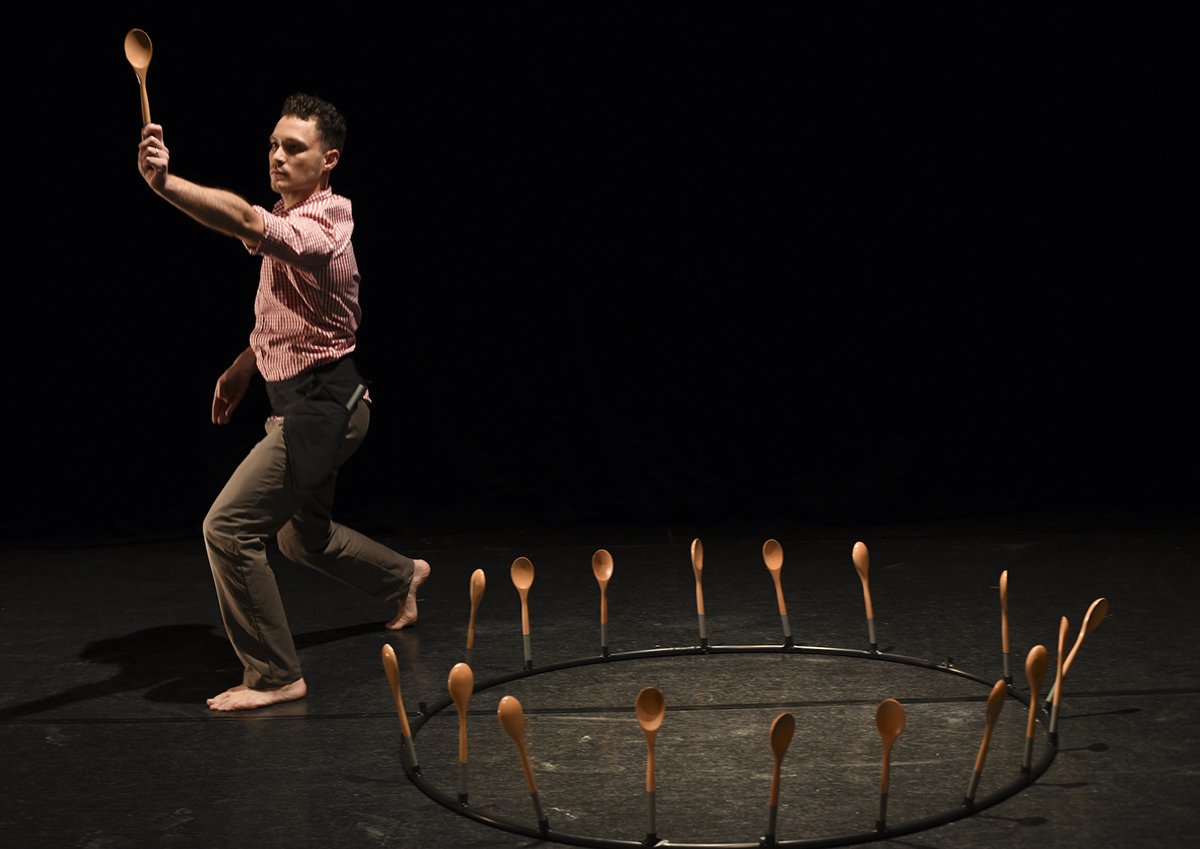
FORM’s Common Anomalies: Dancing with difference
Presented by FORM Dance Projects and Parramatta Riverside Theatres, Common Anomalies is a triptych of solos produced by Carl Sciberras for “young performers” to investigate “cultural identity.”
Imanuel Dado, What We Don’t See
Imanuel Dado begins his solo in a pool of light, dancing a softened krump. While the music mechanically clangs and jingles, a stylish black-on-black costume flows and clings. From internal to external, from contraction to extension, these hydraulic legs, up and down, lever the dance in and out, as Dado leaves and re-enters the light. His hands and face are mobile as he swivels and slides, making circles in discrete body regions until he is wrapped in himself, scared.
White powder breaks the black. Showering in whiteness, creating clouds, Dado smears the black back wall with curves, hand prints and shadows. An ashen man making mess. Drugs? Flour? Washing powder? Ashes?
Forces gather. He is battling, leaning, pounding, hitting, hitting, hitting. Then upside down, fluttering. Where am I? In a solo about choices, Imanuel Dado asks; who are you? Why do you matter? His answer? Listen. Just Listen.

Bhenji Ra, Approaching Gone (#ytfingers), Common Anomalies, FORM Dance Projects, photo Heidrun Löhr
Bhenji Ra: Approaching Gone (#ytfingers)
Bhenji Ra is a trans Filipino-Australian performer who adopts the third person plural pronoun ‘they’ to embody a gendered multiplicity and to politicise experience. Quietly, stealthily they appear in a dark corner of the external courtyard, in a costume that is a love child of the Cookie Monster and a Smurf. Big, blue, with bulbous white eyes atop a round head, the Cookie Smurf treads tenderly. Pudgy blue hands carve calm gestures in a cartoon tai chi. With blue back to the audience, the round belly and soft floppy feet make pelvic sways cutely amusing. But then hip hop Smurf appears, down low. Ra is stripper, sorceress/sorceror, sista/bro: multiple existences that shyly comment on themselves.
They lead us into the theatre slowly, calmly. No rush here. What began in open air silence has become a noisy, smoky, enclosed world. A screen shows rotating two-dimensional figures of goddesses or devils, all horn and tongue behind dripping rain. Where has Cookie Smurf gone? There, in the back corner, doing a half-arsed, almost non-existent dance, mouthing words that cannot be heard amid the din. But words are coming.
The stripper returns, squashing the space between performer and spectator: approaching, touching and sitting, asking to be disrobed, but only a little. The big head is gone. Big sharp ears of wisdom revealed. The miked voice whispers and repeats: “Now that I’ve got you in my space, can I ask you a question?”
The din has subsided, and this slim, breast-less body breathes out, “Can u see it? Can u know it? Can u take it?” Laughingly “Can u rate me” turns into the horror of “I’m a 10” into the even more horrible “Can u kill me” with “ur fat white fingers.” Darker and darker they disappear.

Carl Sciberras, Gbejniet, Common Anomalies, FORM Dance Projects, photo Heidrun Löhr
Carl Sciberras: Gbejniet
Gbejniet is a traditional Maltese cheese. During Gbejniet, Carl Sciberras cooks a soup with this cheese, adding, stirring, smelling, eating. Like the soup and the constant returns to the kitchen, this solo relies on admixture and repetition.
A screen hangs like a framed picture in a living room. Todd Fuller has created animated drawings of departure, travel and arrival. An Italian-esque rolling piano soundtrack travels along with the scenes of hillsides and ships, of land and sea. Meanwhile, the chopping of parsley crunches.
Scriberras frees himself from the kitchen to dance, assembling a quirky circle of standing spoons, pulling each from a holster like a gun. He spins and whisks himself, becoming busier, bolder and bigger, his arms slicing and carving, so fast they become a blur where… he is lost. He returns to his soup.
Balloons, tethered to the Earth with weights, sway and lightly bob like comic sentinels. Sciberras dances a waltzy folk dance, circling a balloon ballroom round and round with an absent partner. Then down he goes, into a rolling set of released floor movements.
An occasional microwave ding humorously breaks up the now laboured piano music as the pot steams and aromas spill. He returns to his soup.
Now he dances alone. He is heating like the soup. The once separated elements are becoming entangled and meshed.
His red and white shirt stained with sweat, he has one last dance. Turning turning turning. Music dissolving. He returns to the soup. He blows to cool it. He eats.
–
FORM Dance Projects & Riverside Theatres: Common Anomalies: Approaching Gone (#ytfingers), choreographer, performer Bhenji Ra, composer Negroma, visual artist Tristan Jallah, costume Matthew Stegh, lighting Mitchell Kroll; What We Don’t See, choreographer, performer, Imanuel Dado, music Ori Lichtic, Olafur Arnalds, Nils Frahm, lighting Mitchell Kroll; Gbejniet, choreographer, performer Carl Sciberras, composer Mitchell Mollison, visual artist Todd Fuller, set, costume design Carl Sciberras, Tricia Cooney, Arnaldo Giordano, lighting, Mitchell Kroll; Lennox Theatre, Parramatta Riverside Theatre, Sydney, 2-4 Nov
Top image credit: Imanuel Dado, What We Don’t See, Common Anomalies, FORM Dance Projects, photo Heidrun Löhr






